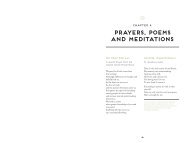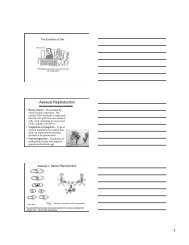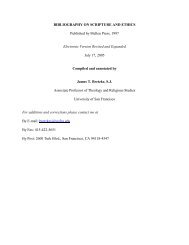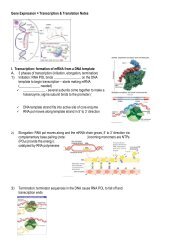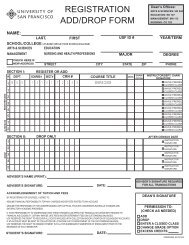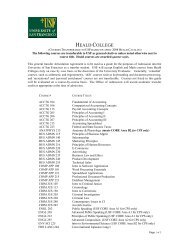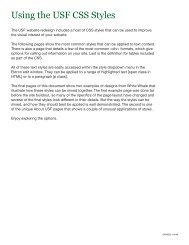I. Genes found on the same chromosome = linked genes
I. Genes found on the same chromosome = linked genes
I. Genes found on the same chromosome = linked genes
You also want an ePaper? Increase the reach of your titles
YUMPU automatically turns print PDFs into web optimized ePapers that Google loves.
Genetic recombinati<strong>on</strong> in<br />
Eukaryotes: crossing over, part 1<br />
I. <str<strong>on</strong>g>Genes</str<strong>on</strong>g> <str<strong>on</strong>g>found</str<strong>on</strong>g> <strong>on</strong> <strong>the</strong> <strong>same</strong><br />
<strong>chromosome</strong> = <strong>linked</strong> <strong>genes</strong><br />
II. Linkage and crossing over<br />
III. Crossing over &<br />
<strong>chromosome</strong> mapping<br />
I. <str<strong>on</strong>g>Genes</str<strong>on</strong>g> <str<strong>on</strong>g>found</str<strong>on</strong>g> <strong>on</strong> <strong>the</strong> <strong>same</strong><br />
<strong>chromosome</strong> = <strong>linked</strong> <strong>genes</strong><br />
C<strong>on</strong>flicting cytological evidence, <strong>on</strong>ly a<br />
few dozen <strong>chromosome</strong>s/individual – so<br />
must be several <strong>genes</strong> per <strong>chromosome</strong><br />
Testcross experiments revealed gene<br />
linkage – observed deviati<strong>on</strong>s from <strong>the</strong><br />
expected 1:1:1:1 ratio based up<strong>on</strong><br />
independent assortment<br />
If a testcross is d<strong>on</strong>e<br />
and <strong>the</strong> <strong>genes</strong> are <strong>on</strong><br />
separate<br />
<strong>chromosome</strong>s:<br />
Chromosome is <strong>the</strong> unit of<br />
transmissi<strong>on</strong>, not <strong>the</strong> gene<br />
Aa/Bb x aa/bb<br />
Aa/Bb<br />
aa/bb<br />
Aa/bb<br />
aa/Bb<br />
2 <strong>genes</strong>, located<br />
<strong>on</strong> different<br />
<strong>chromosome</strong>s,<br />
will segregate<br />
independently.<br />
• Instead, <strong>the</strong> alleles at all loci of <strong>on</strong>e<br />
<strong>chromosome</strong>, should in <strong>the</strong>ory, be<br />
transmitted as a unit during gamete<br />
formati<strong>on</strong>.<br />
1:1:1:1 observed<br />
1
II. Linkage and crossing over<br />
When two <strong>genes</strong> are compeletely <strong>linked</strong>, no crossing over<br />
occurs <strong>the</strong>refore, each gamete receives <strong>the</strong> alleles present<br />
<strong>on</strong> <strong>on</strong>e chromatid or <strong>the</strong> o<strong>the</strong>r:<br />
AB or ab<br />
A. Crossing over – breakage<br />
and rejoining process<br />
between 2 NONSISTER<br />
chromatids<br />
• Crossing over produces<br />
recombinants<br />
• The % of recombinant<br />
gametes varies,<br />
dependent up<strong>on</strong> locati<strong>on</strong><br />
of <strong>the</strong> loci. The closer <strong>the</strong><br />
<strong>genes</strong> are, <strong>the</strong> less likely<br />
recombinati<strong>on</strong> will occur<br />
RECOMBINANT<br />
Breakage and rejoining process between two<br />
homologous n<strong>on</strong>-sister chromatids<br />
-<strong>the</strong>re can be <strong>on</strong>e or more cross-overs<br />
-<strong>the</strong> cross over can occur anywhere<br />
RECOMBINANT<br />
Recombinati<strong>on</strong> Frequency = <strong>the</strong> # of<br />
recombinants/total progeny<br />
2
B. Recombinati<strong>on</strong> Frequency, un<strong>linked</strong><br />
<strong>genes</strong> v. <strong>linked</strong> <strong>genes</strong><br />
1). In <strong>the</strong> case of un<strong>linked</strong> <strong>genes</strong>, independent<br />
assortment holds true…<br />
Testcross: Heterozygous x homozygous mutant<br />
AaBb x aabb<br />
Offspring:<br />
<strong>the</strong> # of recombinants = <strong>the</strong> # of parental types<br />
2). In <strong>the</strong> case of <strong>linked</strong> <strong>genes</strong>, no<br />
independent assortment<br />
• Offspring:<br />
• <strong>the</strong> # of recombinants < <strong>the</strong> # of parental<br />
types<br />
‣ (RF) < 1/2 or 50%<br />
Recombinati<strong>on</strong> Frequency =<br />
‣We can compare <strong>the</strong> RF to what <strong>on</strong>e would expect<br />
with independent assortment…<br />
RF Range – 0% to 50%<br />
RF significantly < 50% - Linkage<br />
RF = 50% - not <strong>linked</strong><br />
•Crossing between adjacent n<strong>on</strong> sister chromatids generates<br />
recombinants<br />
•The two chromatids not involved in <strong>the</strong> exchange result in n<strong>on</strong>parental<br />
gametes<br />
3
Recombinati<strong>on</strong> by Crossing Over – points<br />
to keep in mind:<br />
1. CO’s can occur between any two n<strong>on</strong>sister<br />
chromatids<br />
2. If <strong>the</strong>re is NO crossing over, <strong>on</strong>ly parental<br />
types will be observed<br />
3. If <strong>the</strong>re IS crossing over, RF will increase up<br />
to 50%<br />
4. when <strong>the</strong> loci of two <strong>linked</strong> <strong>genes</strong> are very<br />
far apart, <strong>the</strong> RF approaches 50%, 1:1:1:1<br />
ratio observed, thus transmissi<strong>on</strong> of <strong>the</strong><br />
<strong>linked</strong> <strong>genes</strong> is indistinguishable from that of<br />
two un<strong>linked</strong> <strong>genes</strong><br />
Morgan noted <strong>the</strong> proporti<strong>on</strong> of recombinant<br />
progeny varied depending <strong>on</strong> which <strong>linked</strong> <strong>genes</strong><br />
were being examined…<br />
Testcross F1 results:<br />
pr + pr vg + vg x pr pr vg vg<br />
pr + vg + 1339<br />
pr vg 1195<br />
pr + vg 151<br />
pr vg + 154<br />
RF = 11%<br />
y + y w + w x yy ww<br />
y w 43<br />
y + w 2146<br />
y w + 2302<br />
y + w + 22<br />
RF = 1.4%<br />
As Morgan studied<br />
more <strong>linked</strong> <strong>genes</strong>, he<br />
saw that <strong>the</strong> proporti<strong>on</strong><br />
of recombinant<br />
progeny varied<br />
c<strong>on</strong>siderably.<br />
III. Crossing over & <strong>chromosome</strong> mapping<br />
• Morgan thought <strong>the</strong> variati<strong>on</strong>s in RF might<br />
indicate <strong>the</strong> actual distances separating <strong>genes</strong><br />
<strong>on</strong> <strong>the</strong> <strong>chromosome</strong>s.<br />
• Sturtevant (Morgan’s student) compiled data <strong>on</strong><br />
recombinati<strong>on</strong> between <strong>genes</strong> in Drosophila test<br />
crosses<br />
‣ The closer <strong>the</strong> two <strong>linked</strong> <strong>genes</strong>, <strong>the</strong> lower <strong>the</strong><br />
recombinati<strong>on</strong> frequency- thus RF may be<br />
correlated with <strong>the</strong> map distance between two<br />
loci <strong>on</strong> a <strong>chromosome</strong><br />
A. Linkage Maps<br />
• Linkage of <strong>genes</strong> can be represented in <strong>the</strong><br />
form of a genetic map, which shows <strong>the</strong><br />
linear order of <strong>genes</strong> al<strong>on</strong>g a <strong>chromosome</strong>.<br />
Can also determine <strong>the</strong> distance between <strong>the</strong><br />
<strong>genes</strong>. The % recombinant offspring is<br />
correlated w/<strong>the</strong> distance between <strong>the</strong> two<br />
<strong>genes</strong><br />
4
B. Map Units<br />
• Map Unit (m.u.) = <strong>the</strong> distance between<br />
<strong>genes</strong> for which <strong>on</strong>e product of meiosis<br />
out of 100 is recombinant<br />
• [RF of 1% = 1 m.u. or 1 cM]<br />
• e.g. if RF 12% between A & B, and<br />
28% between B & C:<br />
A B C<br />
12 mu 28 mu<br />
RF – 1.3%, <strong>the</strong>refore y is 1.3mu from w<br />
w 37.2 mu from m<br />
In <strong>the</strong> garden pea, orange pods (orp) are recessive to normal<br />
pods (Orp), and sensitivity to pea mosaic virus (mo) is<br />
recessive to resistance to <strong>the</strong> virus (Mo). A plant with<br />
orange pods and sensitivity is crossed to a true-breeding<br />
plant with normal pods and resistance. The F1 plants<br />
were <strong>the</strong>n test-crossed to plants with orange pods and<br />
sensitivity. The following results were obtained:<br />
160 orange pods/sensitive<br />
165 normal pods/resistant<br />
36 orange pods/resistant<br />
39 normal pods/sensitive<br />
calculate <strong>the</strong> map distance between <strong>the</strong> two <strong>genes</strong><br />
5
C. Mapping multiple <strong>genes</strong> – Threepoint<br />
mapping & Alfred’s research<br />
• Hypo<strong>the</strong>sis = when<br />
multiple <strong>genes</strong> are<br />
located <strong>on</strong> <strong>the</strong> <strong>same</strong><br />
<strong>chromosome</strong>, <strong>the</strong><br />
distance between <strong>the</strong><br />
<strong>genes</strong> can be estimated<br />
from <strong>the</strong> proporti<strong>on</strong> of<br />
recombinant offspring.<br />
• Sturtevant’s First Genetic<br />
Map<br />
A. Sturtevant’s First Genetic Map<br />
• The linear order of <strong>the</strong>se <strong>genes</strong> can be determined using<br />
testcross data<br />
Examined 5 different <strong>genes</strong>: y, w, v, m, r<br />
• All alleles were <str<strong>on</strong>g>found</str<strong>on</strong>g> to be recessive and X <strong>linked</strong>.<br />
• Crossed <strong>the</strong> double heterozygote female with<br />
hemizygous male recessive for <strong>the</strong> <strong>same</strong> alleles.<br />
Example: y+y w+w x yw w+w r+r x wr<br />
y+w+<br />
yw<br />
y+w<br />
yw+<br />
w+r+<br />
wr<br />
w+r<br />
wr+<br />
RF = 214/21,736 = 0.0098<br />
RF = 2,062/6116 = 0.337<br />
1 mu between y & w, 33.7 mu between w & r<br />
<strong>genes</strong> are arranged <strong>on</strong> <strong>the</strong> <strong>chromosome</strong> in a linear<br />
order- which can be determined…<br />
The Complete Data:<br />
Alleles # R./total#<br />
y and w 214/21,736<br />
y and v 1,464/4,551<br />
y and r 115/324<br />
y and m 260/693<br />
w and v 471/1,584<br />
w and r 2,062/6116<br />
w and m 406/898<br />
v and r 17/573<br />
w and m 109/405<br />
RF<br />
1%<br />
32.2%<br />
35.5%<br />
37.5%<br />
29.7%<br />
33.7%<br />
45.2%<br />
3%<br />
26.9%<br />
6
y-w = 1 m.u.<br />
v-r = 3 m.u.<br />
y-m = 37.5 m.u.<br />
w-r = 33.7 m.u.<br />
w-v = 29.7 m.u.<br />
Suggesting that v is between r<br />
& w, but closer to r<br />
Map distances more accurate<br />
between <strong>genes</strong> that are closer<br />
toge<strong>the</strong>r, as <strong>the</strong> RF approaches<br />
50%, <strong>the</strong> value becomes more<br />
inaccurate as a measure of map<br />
distance…<br />
7



